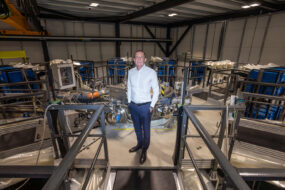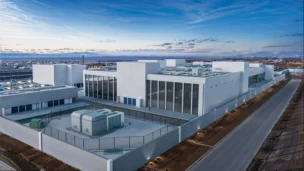As the advanced nuclear sector gets closer to commercialization, firms are eyeing the public markets for access to capital and to take advantage of public excitement for a potential new, clean, safe energy source.
Terrestrial Energy is the latest nuclear firm to finalize plans to go public. The molten salt reactor company announced in March that it will enter the public markets via SPAC. The transaction is expected to close in Q4, generating up to $280M in gross proceeds.
Ignition sat down with Terrestrial Energy CEO Simon Irish to discuss the opportunities in the advanced nuclear sector, why the company is choosing to brave the public markets, and the company’s developmental progress.
Note: This interview has been edited for length and clarity.
Ignition: Let’s start off talking about your path into the nuclear energy sector. What got you interested?
Irish: I Worked in London financial services for much of the 90s and was at a company called Credit Suisse Financial Products, which was very much an elite player in the derivatives business at the time. I moved into asset management on the buy side, and very quickly moved from New York and went in for a company called Man Group, a time when there was a tremendous amount of innovation and development going on in the alternative world. In 2009 I took a sabbatical to think about the next big thing. Energy has always been this great enabler of human progress. So I started thinking about the energy world. And the first thing I realized about it is the scale of it is enormous. And with enormous scale is a number of major problems. We are concerned about energy supply. That’s a big, big thing. We’re concerned about environmental standards. That’s a big, big thing. And we’re also going to deal with expanding energy supply. The only thing that, in my opinion, can actually address these problems at scale is nuclear energy.
If you want to solve the really big problems today, it has to be nuclear. It can be nothing else. It’s not as if it’s a choice, where you’ve got three choices to pick your favorite one. There is no choice. On a first principles basis, there’s nothing that can possibly achieve those three ambitions: security, environmental, and growth. There’s nothing that even comes close. So the question is, you have to look at the nuclear machine. And we live in a commercial world. Nothing happens in the world unless it’s married to capital. If it’s married to capital, something happens, but if it doesn’t, it remains a curiosity.
My sabbatical was certainly extending beyond three months at this point in time, and I started looking at behind the curtain, behind the market, at all the nuclear machines that had been developed over the last 60 or 70 years. But it never strayed from behind that curtain separating the national labs from the markets. The market is monochromatic. If you sort of pull back the curtain, you have this kaleidoscope of different nuclear machines, all these different technologies, many of them now called Gen IV technologies. Perhaps one of these technologies, on the first principles basis, is going to be the technology and to be the nuclear machine that solves the market problem, which is affordability and cost.
I gravitated towards a molten salt reactor technology because it was uniquely and distinctly different from every other technology that had been developed. And it’s unique and distinctly different because it uses a molten fuel and a molten salt as a single salt eutectic, which is a fundamentally different method of harnessing nuclear energy compared to the method used by the reactors that have solid fuel in some type of assembly and the application of a coolant to that solid fuel.
With a thermally very stable coolant, you had a reactor system that got very hot. When you had a nuclear system that got very hot, it had the capability of being a very much more efficient machine. So that’s why, during my sabbatical, I got interested in molten salt reactors solving that fundamental limiting problem for new energy supply, which is affordability and cost. You’ve got three operating characteristics that are key. First one is temperature, second one is pressure, third one is inherent safety. So high temperature, low pressure, high inherent safety. Those are powerful economic virtues. A current nuclear machine, a light water reactor, has low temperature, bad machine efficiency, high pressure, a very complicated, challenging engineering environment, and we believe it’s an economic penalty.
You mentioned the fundamental economic weakness of fission reactors today, and I’d like to hear more about how molten salt reactors are different when you’re talking about that temperature differential and efficiency.
It’s the same efficiency as a coal plant, because coal would burn very hot. So we have the same thermal efficiency as a coal plant. Why? Because we create the same steam conditions for our steam turbines as a coal plant. So if you’re looking to displace less environmentally attractive means of generation, you want a machine that’s as financially efficient as the thing you’re trying to displace. So we’re as efficient as a coal plant, but we’re looking to compete with coal.
At this point you still run into those first-of-a-kind costs and supply chain development needs to bring costs down. At this point in time, how do you see the development of those components going, and at what point can a molten salt reactor compete with something like coal?
I was talking about this in 2012, 2013, and these are the fundamental underpinnings to the foundation of Terrestrial Energy. Everything at some point falls into the fundamental hole. You want to align yourself with the fundamentals, and then you get on with the job.
It’s extremely exciting because we started our journey 12 years ago, 13 years ago, developing this design, developing our supply chain, engaging in the regulation process, on both sides of the border in Canada and the United States, and being able to come to the table now with a substantial package of of engineering and regulatory and supply chain developments at a very, very exciting time when we’re now without looking to to push hard on the commercialization of this technology.
You mentioned that with traditional fission reactors, that high pressure environment impacts the ability of that technology to earn licenses. Have you seen that it is simpler on the regulatory side for a molten salt reactor?
Our mechanisms of nuclear safety are really quite different compared to the mechanisms of light water reactor safety. We’ve presented those mechanisms to the Canadian Nuclear Safety Commission over the course of a program that’s referred to as event design review. This is a program that the Canadian regulator offers to developers that can be undertaken in mid-design. You don’t want to complete your design, take your design to the regulator and ask them what they think. You want input while you’re doing it. That’s commercially very valuable, and that’s why we chose the event design would be offered by the Canadian regulator. That was completed in April 2023 and in many respects that is a very important milestone for the company.
As a consequence of that deep, multi-year engagement with the Canadian regulator, we have a great deal of transparency on the licensability of the nuclear technology. Terrestrial Energy became I think the first in Western markets, at least, to take a molten salt reactor design to the regulator and say, “Here we are, this is our design. Could you please assess it against nuclear safety standards and tell us what you think.”
In april 2023 I think the world was waking up to the fact that we needed vast expansion of nuclear energy. At the end of 2023 you had that COP28 statement which sort of exemplifies that change in attitude, we have to triple nuclear generation supply by mid century. This happenstance, which I say, is sort of good fortune, means we will now be able to aggressively push on commercialization with that regulatory answer at a time when you had a tremendous change in market circumstances. I think that’s a little bit of good luck, actually, for us.
How is development going on the reactor itself? Where are you at in construction, supply chain development, things like that?
It was important for us is to build an active supply chain. We think that the valuable proposal to the market is not demonstrating how you can build one plant, it’s demonstrating how you build a fleet of plants. If that’s your business, you have to look behind your supply chain and say, to what extent am I pulling my supply chain in behind me? To what extent am I using the scale of my supply chain to deliver at fleet scale? So supply chain development is very important.
One of the key components is fuel, where we’re going to get standard assay uranium from. And if you’re following the HALEU story, you’re in a much better place if you’re not using HALEU. So we’re using a standard level enrichment. So we had the ability to design our system to use standard nuclear fuel. And we’ve got an active program of fuel development, production development, including an engagement with Westinghouse at their Springfield facility in Preston in the UK, Lancashire.
What about on the molten salt side?
There are some molten salts that have exotic elements to it, but we don’t use lithium and we don’t use beryllium. The other elements in our salts are relatively standard industrial elements. This also sits within our philosophy of trying to avoid the pinch points in the supply chain.
And then is that put together in house, that concoction of fuel and coolant?
Our nuclear system has a very explicit set of fuel requirements. So because we design the system, we know what they are, so we’d be supplying the fuel which is compliant with the design requirements of the nuclear system that we’re developing.
Are there any particular bottlenecks that you are anticipating with the design of the rest of the reactor or plant build?
There is work to do on supply chain. I wouldn’t want to use the word bottlenecks to suggest something that’s immovable or something that is a massive challenge that you have to overcome. We think it’s within a relatively normal core strategy to develop supply at scale.
Tell me a little bit about the strategy that you’re taking towards commercial development. This fleet scale approach seems to be a central part of the Terrestrial strategy. How have you been going about working towards that fleet scale deployment?
Firstly, we are almost exclusively focused on the US market now, because I think the US market offers a set of commercial dynamics that just can’t be matched in other markets.
Our business is not to build and operate these plants. Others are, ours isn’t. That gives us the ability to push a lot of the elements on project delivery, commissioning the power plant, down into our supply chain, and using the scale that they have to achieve fleet scale.
If you’re not looking to build and operate, then you can share the elements of your project with companies who do this on a regular basis. So a big utility, a big construction company, a big engineering company. Your business model is to provide a number of the essential services and components, some of which are acquired during construction and even pre-construction. But we’re not looking to be the project lead on a nuclear power plant. We will expect a big EPC to play an important role on project management. We’ll be supplying the key component, which is, in our case, that component called the IMSR core unit. That’s where our IP sits, and that’s the innovation that gives life to the molten salt reactor.
Each project involves us as the technology supplier, but also members of our supply chain as well. So when we are developing the project and bidding a project into, let’s say, a tech company that wants to use this for power supply, we’ll be drawing from our supply chain in terms of, you know, advising someone to join the consortium as operator, constructor, who’s going to supply the components, and so forth.
Tell me a little bit about the reasoning and planning behind the decision Terrestrial recently made to enter the public markets via SPAC.
This is driven by timing, and it’s timing because we believe, looking at how demand has changed over the last 24 months, this is a big signal to those on the supply side market to ramp up their development, so we are looking to do that. We’re looking to aggressively ramp up our commercialization program. If you’re looking to ramp up your commercialization program, you need to be thinking about your capital plan as well. We think that the most suitable capital plan for us to accelerate that development and ramp up our commercialization is to secure a public listing. I think a lot of public market investors recognize that they want to get exposure to these really big innovation factors. The nuclear innovation factor is entirely secular. This is not cyclical. This doesn’t happen once every 10 years. There’s something that’s happening now which is transformative in nuclear energy supply. This is structural. We’re seeing strong appeal for our business and public markets, and in terms of securing the capital we need to execute aggressively on our business plan, we think it’s very good alignment now, and that creates the circumstances to go public.
In other industries, like aerospace SPACs have fared less well, because of the public markets sensitivity to delays and early failures. What does that mean for Terrestrial to be building new technology in the public sphere?
Certainly going public places,an extra set of demands on the operation of the corporation. That’s the other side of the coin. It is what is required, and we have made a decision that will meet that requirement by expanding out the corporate capabilities of the company. I think shareholders, whether public or private, want to know how the company is doing. I think certainly given what’s going on, given the pace of development, I would think that shareholders would be particularly interested to see how you’re getting on. So we’re very excited about this transaction.
What does the scaling effort in the first few months of your life as a public company look like?
The RELLIS project is something that we’ll be talking about quite actively in the future. But that capital will allow us to put a push aggressively to continue developing our supply chain, to continue to develop the component supply as well, particularly IMSR core units. We’ll expand resources so we can participate much more widely in the opportunity set that we’re seeing in the United States.
Lead Reporter of Ignition





